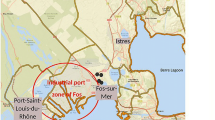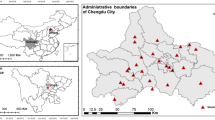Abstract
Numerous studies have reported polychlorinated biphenyl (PCB) concentrations in soil, root, and aerial parts of vegetables. However, few studies have measured the contribution of PCBs bound to particles in air in relation to uptake by vegetables. In the present study, PCB concentrations were measured in five types of vegetables, soil, and settled air particle samples from two sites (at a domestic waste incinerator and at 20 km away from the incinerator) in Guangzhou, South China. ∑PCB concentrations in rhizosphere soil samples from the two sites ranged from 17.2–77.7 to 5.48–25.57 ng/g, respectively. ∑PCB concentrations in aerial parts of vegetables were greater than those in rhizosphere soils and roots with median values of 108 and 47.08 ng/g, respectively. Among the five types of vegetables studied, the highest concentration of PCBs was found in bitter lettuce. No significant correlation between PCBs in soil and roots or aerial parts of vegetables was observed. However, principal component analysis indicated that settled air particles were the dominant source of PCBs in the aerial parts of vegetables. In addition, similar PCB congener profiles were found in the aerial parts of vegetables and settled air particles. This suggests that foliar uptake of PCBs is an important pathway. Risk assessment indicated that human exposure to PCBs by way of dietary intake of vegetables from incinerator sites would result in high risk.




Similar content being viewed by others
References
An Q, Dong YH, Wang H, Ceng F, Zhang J (2006) Residues of PCBs in agricultural fields in the yangtze delta, China. Chin J Environ Sci 3:528–532
Chen DX (2004) Approach of building municipal solid waste incineration plant in China. J Environ Protect 1:47–48
Chen LG (2008) Comparison of PCBs and PBDEs concentrations and compositions in the Guangzhou atmosphere in summer. Acta Sci Circumst 28:150–159
Clothier BE, Green SR (1997) Roots: the big movers of water and chemical in soil. J Soil Sci 162:534–543
Eero P, Sannamari H, Jaana S (2005) PCB contamination from polysulphide sealants in residential areas—exposure and risk assessment. Chemosphere 59:537–543
Fan GL, Cui ZJ (2009) A review on the sources, distribution and metabolism of PCBs in plants. Plant Sci J 27:423–428
Kang Y, Yin Y, Man YB, Li LS, Zhang QY, Zeng LX, Luo JW, Wong MH (2013) Bioaccessibility of polychlorinated biphenyls in workplace dust and its implication for risk assessment. Chemosphere 93:924–930
McLachlan MS (1996) Bioaccumulation of hydrophobic chemicals in agricultural feed chains. Environ Sci Technol 30:252–259
Moeckel C, Thomas G, Barber J, Jones KC (2008) Uptake and storage of PCBs by plant cuticles. Environ Sci Technol 42:100–105
Sena MM, Frighetto RTS, Valarini PJ, Tokeshi H, Poppi R (2002) Discrimination of management effects on soil parameters by using principal component analysis: a multivariate analysis case study. Soil Till Res 67:171–181
Simonich S, Hites A (1995) Organic pollutant accumulation in vegetation. Environ Sci Technol 29:2905–2914
St Amand AD, Mayer PM, Blais JM (2007) Modeling atmospheric vegetation uptake of PBDEs using field measurements. Environ Sci Technol 41:4234–4239
UNEP (United Nations Environment Programme) (2005) E-Waste: the Hidden side of IT Equipment’s Manufacturing and Use. Early Warnings on Emerging Environmental Threats
USEPA (1994) Method of semivolatile organic compounds. EPA 3540. United States Environmental Protection Agency, Washington, DC
USEPA (1996) PCBs: Cancer dose response assessment and application to environmental mixtures. EPA 600-P-96-001F. United States Environmental Protection Agency, Washington, DC
USEPA (1997) Exposure Factors Handbook. EPA/600/C-99/001. U.S. Environmental Protection Agency, Washington, DC
USEPA (2006) Integrated Risk Information System (IRIS). United States Environmental Protection Agency, Washington DC
Voutsa D, Samara C (1998) Dietary intake of trace elements and polychlorinated biphenyls via vegetables grown in an industrial Greek area. Sci Total Environ 218:203–216
Wang DG, Yang M, Jia HL, Zhou L, Li YF (2008) Levels, distributions and profiles of polychlorinated biphenyls in surface soils of Dalian, China. Chemosphere 73:38–42
Wang Q, Shi YH, Hu XJ, Yao ZW, Fang KX, Dong YA (2012) Determination of dioxin-like polychlorinated biphenyls in soil and moss from Fildes Peninsula, Antarctica. Chin Sci Bull 57:992–996
Zhang HB, Li XH, Luo YM (2011) Depth distribution of polychlorinated biphenyls in soils of the Yangtze River Delta region, China. Geoderma 160:408–413
Zhao GF, Wang ZJ, Dong MH, Rao KF, Luo JP, Wang DH, Zha JM, Huang SB, Xu YP, Ma M (2008) PBBs, PBDEs, and PCBs levels in hair of residents around e-waste disassembly sites in Zhejiang Province, China, and their potential sources. Sci Total Environ 397:46–57
Zhao GF, Zhou HD, Wang DH, Zha JM, Xu YP, Rao KF, Ma M, Huang SB, Wang ZJ (2009) PBBs, PBDEs, and PCBs in foods collected from e-waste disassembly sites and daily intake by local residents. Sci Total Environ 407:2565–2575
Zhou JC, Bi CJ, Chen ZL, Tao SG, Xu SY (2010) Residues of polychlorinated biphenyls in agricultural fields of Chongming Island in Shanghai, China. China Environ Sci 30:116–120
Acknowledgments
Financial support from the National Natural Science Foundation of China (Grant No. 41301563), Natural Science Foundation of Guangdong Province, China (Grant No. S2013040015624), and Young Scientist Incubation Fund of South China Normal University (Grant No. 2012KJ003) are gratefully acknowledged.
Author information
Authors and Affiliations
Corresponding authors
Additional information
Lixuan Zeng and Ning Li have contributed equally to this work.
Rights and permissions
About this article
Cite this article
Zeng, L., Li, N., Shao, D. et al. Concentrations, Sources, and Risk Assessment of Polychlorinated Biphenyls in Vegetables Near a Waste-Incinerator Site, South China. Arch Environ Contam Toxicol 67, 78–86 (2014). https://doi.org/10.1007/s00244-014-0045-3
Received:
Accepted:
Published:
Issue Date:
DOI: https://doi.org/10.1007/s00244-014-0045-3




